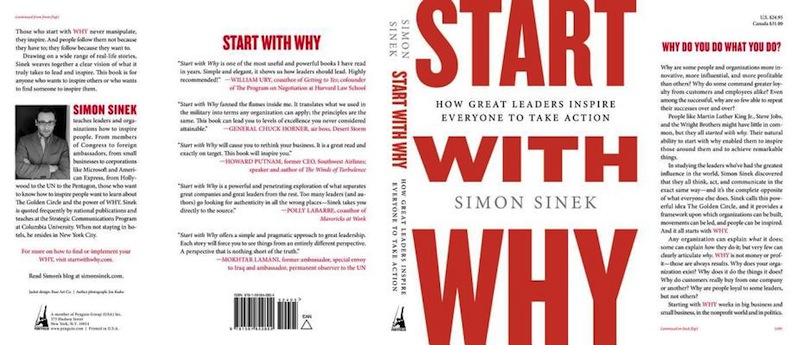
Start with WHY by Simon Sinek
It’s 1907. Samuel Pierpont Langley wants to be the first man to pilot an airplane. He’s well-funded by the War Department and he hires a talented team to help him. But he dreams of achievement more than he dreams of flight.
The Wright Brothers, on the other hand, want to soar. Their vision inspires those around them. Working out of a bicycle shop with an unfunded rag-tag crew of mechanics, they beat Langley and his team to the sky.
In Start With WHY, Simon Sinek writes that clarity of purpose drives innovation in the same way that it drives a purchase. “People don’t buy WHAT you do,” Sinek says, “they buy WHY you do it.” He points to enduring companies, leaders, and communicators that unite their teams, products, and customers with their overarching causes.
Southwest and Song
It’s 2003. You’re flying from New York City to San Francisco.
You’ve narrowed it down to two flights. One of them is with Delta’s low-cost airline, Song. The other is with Southwest. The price difference is negligible. Which flight will you take?
In this instance, the WHATs (the flights) are basically the same. But the WHYs are strikingly different. Southwest’s purpose is to make a pleasurable flight available to regular folk. Its famous motto, “You are now free to move about the country,” is not a slogan. It’s a mission. When Herb Kelleher founded Southwest, most people couldn’t afford to fly. And when he ran the company, he made every decision – from hot pants, whiskey, and ten minute turnaround times – by adhering to this basic mission.
Delta was different. It had a different WHY. This ad is more along the lines of Delta’s identity. Dolphins and synchronized planes, set to majestic chanting, is fun. But the feel of the message is elite and its core is order.
When Delta came out with Song Airlines, it didn’t make sense. Song was fun – it offered in-flight exercise programs designed by David Barton, uniforms designed by Kate Spade, and cocktails created by Rande Gerber – but nobody understood why Song existed. It failed within three years, though it should have succeeded by all objective measures.
Why does WHY make such a difference for a company? Sinek calls on neurobiology to explain.
It’s Then. It’s Now. It’s Timeless
People respond to WHY because people are built to respond to WHY. In broad strokes, the limbic system regulates emotion and action. The neocortex is devoted to thinking. For more on this, check out the limbic system, where humans process WHY, and the neocortex, where humans process WHAT. In essence, WHAT makes people stop to think while the WHY literally moves people.
WHY has everything to do with Mac putting a dent in the universe. It’s responsible for Microsoft maximizing human efficiency by getting a computer in nearly every home. It brought 250,000 to Washington Square in 1963 and landed man on the moon at the end of that decade.
The list goes on. Those who start with WHY and stick with it move people. Companies that do so make great brands because they draw people who believe what they believe.
Every company exists for a unique reason that distinguishes it from its competitors. When that company acts on its purpose, it attracts and inspires employees and buyers who identify with it viscerally. This emotional connection is key to innovation and customer loyalty. Customers are happier when they buy from such brands because they’re buying more than a product. They’re affirming who they are.
…………………………………………………………………………………………………………………………………………………………………………………………….
Any thoughts on this book? Have you read it? If so, what were your takeaways? Let us know in the comments and connect with us on Twitter, Facebook, Google+, and LinkedIn.
Register for our FREE Resource Center and Newsletter to access our growing library of valuable Guide Books, Tip Sheets, and more!